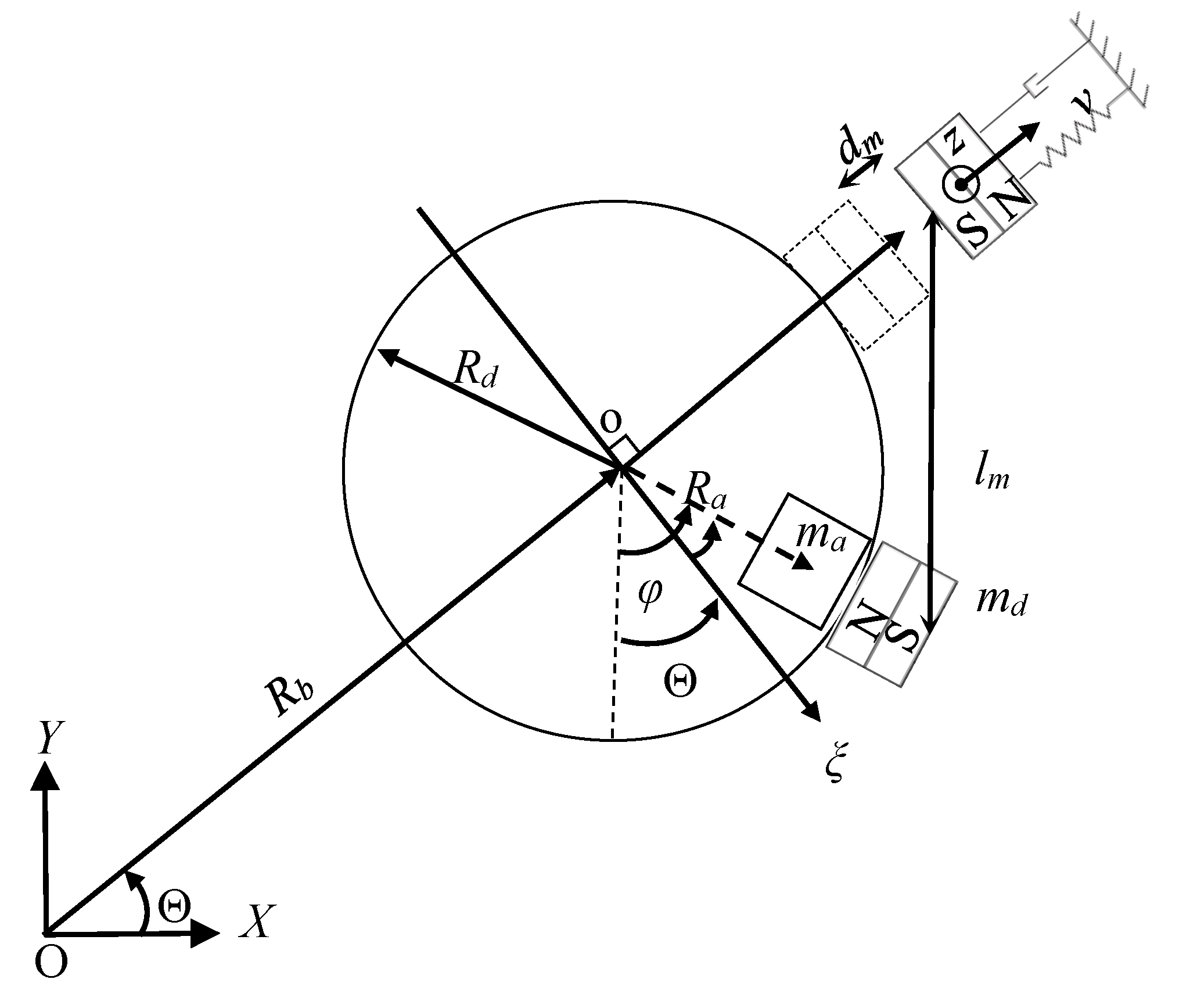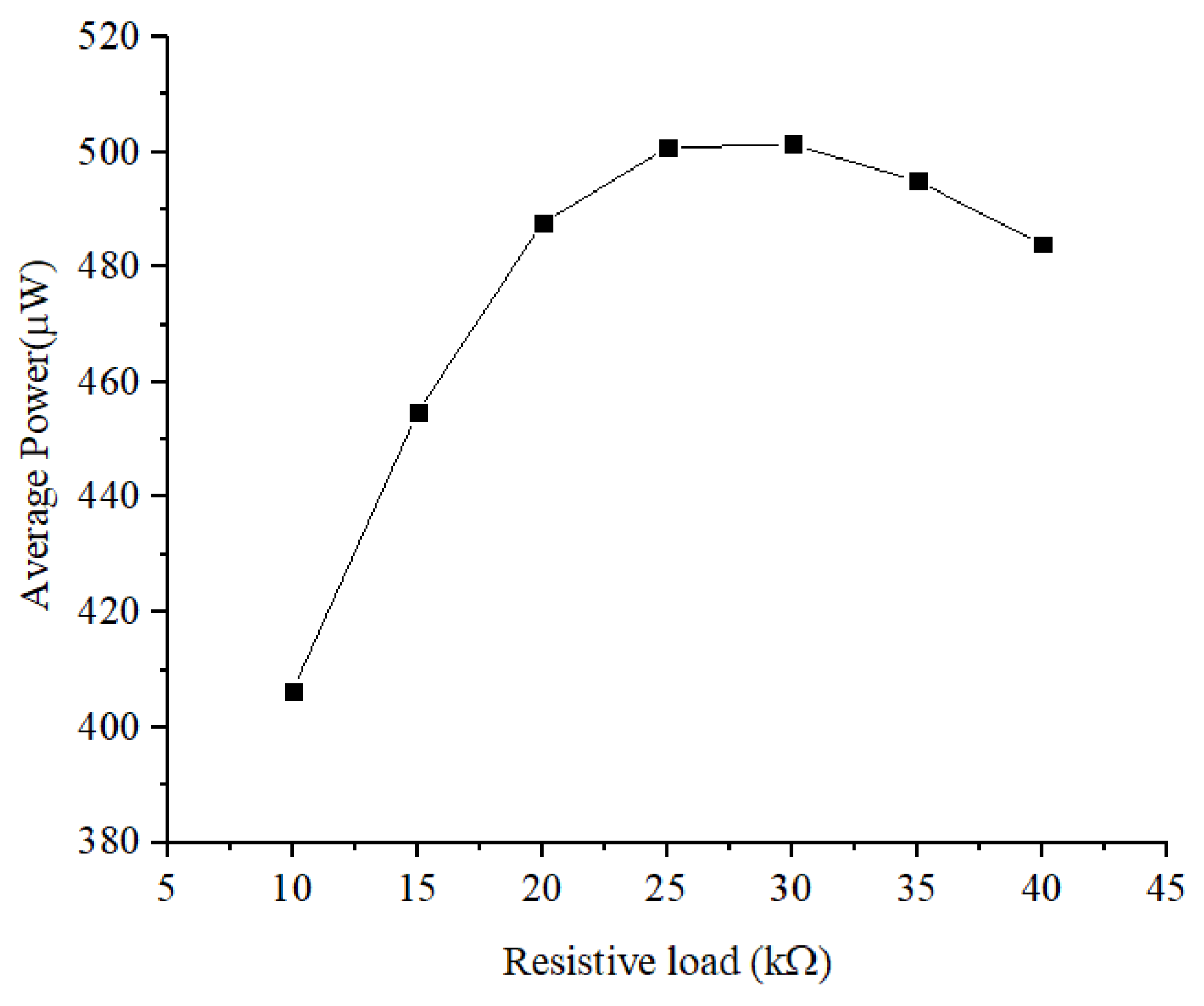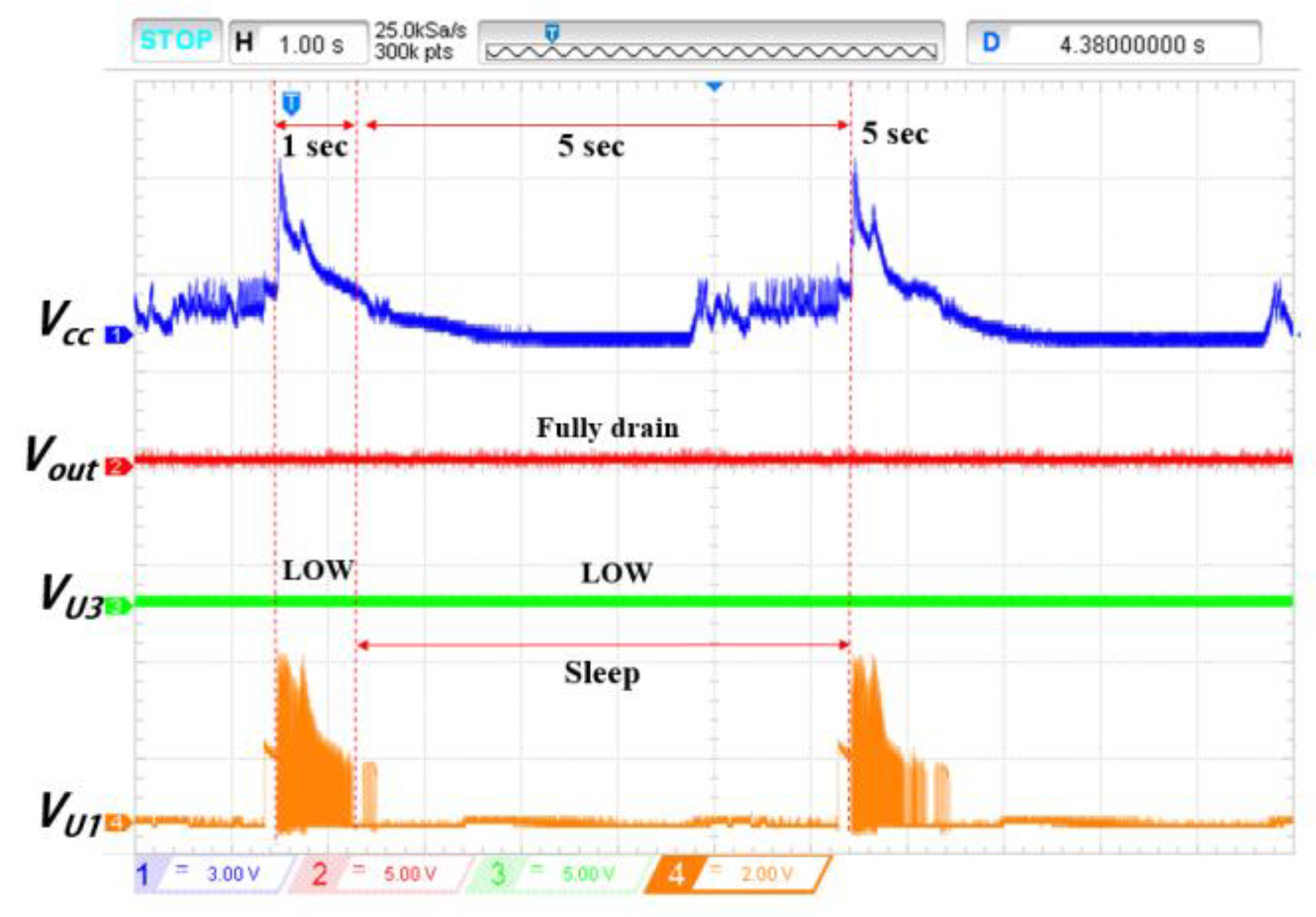Power Supply Switch Circuit for Intermittent Energy Harvesting
Abstract
:1. Introduction
2. PEH with Gravity-Induced Disk
2.1. Dynamics Modeling of Harvester and Simulation
2.2. Prototype of A PEH With Gravity-Induced Rotator and Experimental Results
3. Proposed Power Management Circuit
3.1. Rectifier and Buck-Boost DC–DC Converter
3.2. Self-Start Controller and Oscillator
3.2.1. Self-Start Controller
- Case 1: When the storage device is fully drained and Vcc is higher than the threshold because of the energy generated by the PEH. In this case, Vout is lower than the threshold voltage, and both the comparator U2 and the AND gate U3 are deactivated because the storage device voltage is lower than the minimum operating voltage of U2 and U3. That makes the output of U2 and U3 LOW signal. The inverter logic gate U4 receives LOW and reverses it to HIGH that turns ON LDO U5 that starts powering the oscillator for impedance matching. When the PEH stops power generation, the inverter logic gate U4 and LDO U5 automatically stop the operation to save power.
- Case 1 to Case 2: When Vout is higher than the threshold value (2 V), U2 is activated to compare Vref and the output of voltage divider sourced by Vout. When this output is higher than Vref, an operation case is changed from Case 1 to Case 2.
- Case 2: When the storage device is charged to power the controller. In this case, Vout becomes higher than the threshold and the comparator U2 sends HIGH signal to one input of AND gate U3 and the inverter gate U4. The inverter gate U4 receives HIGH from U2 and sends LOW to the LDO (ON/OFF pin) to deactivate the LDO and save power. When the PEH generates power, Vcc is higher than the threshold, and all of the inputs to the AND gate U3 are HIGH as well as its output. Then it starts powering the oscillator. When the PEH stops power generation and Vcc becomes lower than the threshold voltage, the output of AND gate U3 becomes LOW and it stops power supply to the oscillator. In this case, LDO turns naturally off because the current does not flow to LDO.
3.2.2. Oscillator
4. Prototype and Experimental Results
4.1. Self-Start Controller and Oscillator
4.1.1. Case 1
4.1.2. Case 2
4.2. Circuit Efficiency and Power Consumption
4.2.1. Circuit Efficiency
4.2.2. Power Dissipation of the Controller
5. Conclusions
Author Contributions
Funding
Conflicts of Interest
References
- Wilkinson, M.; Spianto, F.; Knowles, M. Towards the Zero Maintenance Wind Turbine. In Proceedings of the 41st International Universities Power Engineering Conference, Newcastle-upon-Tyne, UK, 6–8 September 2006. [Google Scholar] [CrossRef]
- McMillan, D.; Ault, G.W. Quantification of Condition Monitoring Benefit for Offshore Wind Turbines. Wind. Eng. 2007, 31, 267–285. [Google Scholar] [CrossRef]
- Liu, W.; Tang, B.; Jiang, Y. Status and problems of wind turbine structural health monitoring techniques in China. Renew. Energy 2010, 35, 1414–1418. [Google Scholar] [CrossRef]
- Walford, C.A. Wind Turbine Reliability: Understanding and Minimizing Wind Turbine Operation and Maintenance Costs. Available online: https://www.osti.gov/biblio/882048/ (accessed on 9 January 2019).
- Hatch, C. Improved wind turbine condition monitoring using acceleration enveloping. Orbit 2004, 61, 58–61. [Google Scholar]
- Froese, M. Assessing Condition-Based Monitoring and Preventative Turbine Maintenance. Available online: https://www.windpowerengineering.com/operations-maintenance/condition-monitoring-maintenance/assessing-condition-based-monitoring-preventative-turbine-maintenance/ (accessed on 13 August 2018).
- Schubel, P.; Crossley, R.; Boateng, E.; Hutchinson, J.; Crossley, R. Review of structural health and cure monitoring techniques for large wind turbine blades. Renew. Energy 2013, 51, 113–123. [Google Scholar] [CrossRef]
- Song, Z.; Zhang, Z.; Jiang, Y.; Zhu, J. Wind turbine health state monitoring based on a Bayesian data-driven approach. Renew. Energy 2018, 125, 172–181. [Google Scholar] [CrossRef]
- Yang, W.; Court, R.; Jiang, J. Wind turbine condition monitoring by the approach of SCADA data analysis. Renew. Energy 2013, 53, 365–376. [Google Scholar] [CrossRef]
- Worms, K.; Klamouris, C.; Wegh, F.; Meder, L.; Volkmer, D.; Philipps, S.P.; Reichmuth, S.K.; Helmers, H.; Kunadt, A.; Vourvoulakis, J.; et al. Reliable and lightning-safe monitoring of wind turbine rotor blades using optically powered sensors. Wind Energy 2016, 20, 345–360. [Google Scholar] [CrossRef]
- Esu, O.; Lloyd, S.; Flint, J.; Watson, S.; Lloyd, S. Feasibility of a fully autonomous wireless monitoring system for a wind turbine blade. Renew. Energy 2016, 97, 89–96. [Google Scholar] [CrossRef]
- Joyce, B.S. Development of an Electromagnetic Energy Harvester for Monitoring Wind Turbine Blades. Available online: http://hdl.handle.net/10919/36354 (accessed on 27 July 2018).
- Nezami, S.; Lee, S.; Jin, J.; Kang, K.-W. Shape optimization of railroad vibration energy harvester for structural robustness and power generation performance. Eng. Struct. 2018, 173, 460–471. [Google Scholar] [CrossRef]
- Anton, S.R.; Sodano, H.A. A review of power harvesting using piezoelectric materials (2003–2006). Smart Mater. Struct. 2007, 16, R1–R21. [Google Scholar] [CrossRef]
- Nezami, S.; Jung, H.J.; Lee, S. Design of a disk-swing driven piezoelectric energy harvester for slow rotary system application. Smart Mater. Struct. 2019, 28, 074001. [Google Scholar] [CrossRef]
- Kong, N.; Ha, D.S.; Erturk, A.; Inman, D.J. Resistive Impedance Matching Circuit for Piezoelectric Energy Harvesting. J. Intell. Mater. Syst. Struct. 2010, 21, 1293–1302. [Google Scholar] [CrossRef]
- Ottman, G.; Hofmann, H.; Bhatt, A.; Lesieutre, G.; Lesieutre, G. Adaptive piezoelectric energy harvesting circuit for wireless remote power supply. IEEE Trans. Power Electron. 2002, 17, 669–676. [Google Scholar] [CrossRef]
- Yi, J.; Su, F.; Lam, Y.-H.; Ki, W.-H.; Tsui, C.-Y. An energy-adaptive MPPT power management unit for micro-power vibration energy harvesting. In Proceedings of the 2008 IEEE International Symposium on Circuits and Systems, Seattle, WA, USA, 18–21 May 2008; pp. 2570–2573. [Google Scholar]
- Kawai, N.; Kushino, Y.; Koizumi, H. MPPT controled piezoelectric energy harvesting circuit using synchronized switch harvesting on inductor. In Proceedings of the IECON 2015-41st Annual Conference of the IEEE Industrial Electronics Society, Yokohama, Japan, 9–12 November 2015. [Google Scholar] [CrossRef]
- Chew, Z.J.; Zhu, M. Microwatt power consumption maximum power point tracking circuit using an analogue differentiator for piezoelectric energy harvesting. J. Phys. Conf. Ser. 2015, 660, 012022. [Google Scholar] [CrossRef]
- Darmayuda, I.M.; Gao, Y.; Tan, M.T.; Cheng, S.-J.; Zheng, Y.; Je, M.; Heng, C.-H. A Self-Powered Power Conditioning IC for Piezoelectric Energy Harvesting From Short-Duration Vibrations. IEEE Trans. Circuits Syst. II Express Briefs 2012, 59, 578–582. [Google Scholar] [CrossRef]
- Wu, L.; Do, X.-D.; Lee, S.-G.; Ha, D.S. A Self-Powered and Optimal SSHI Circuit Integrated With an Active Rectifier for Piezoelectric Energy Harvesting. IEEE Trans. Circuits Syst. Regul. Pap. 2017, 64, 537–549. [Google Scholar] [CrossRef]
- Guyomar, D.; Lallart, M. Recent Progress in Piezoelectric Conversion and Energy Harvesting Using Nonlinear Electronic Interfaces and Issues in Small Scale Implementation. Micromachines 2011, 2, 274–294. [Google Scholar] [CrossRef]
- Shim, M.; Kim, J.; Jeong, J.; Park, S.; Kim, C. Self-powered 30 μw to 10 mw piezoelectric energy harvesting system with 9.09 ms/v maximum power point tracking time. IEEE J. Solid-State Circuits 2015, 50, 2367–2379. [Google Scholar] [CrossRef]
- Szarka, G.D.; Burrow, S.G.; Stark, B.H. Ultralow Power, Fully Autonomous Boost Rectifier for Electromagnetic Energy Harvesters. IEEE Trans. Power Electron. 2013, 28, 3353–3362. [Google Scholar] [CrossRef]
- Bohan, J.E., Jr. Google Patents, Assignee. Low Voltage Driven Oscillator Circuit. U.S. patent 4,734,658, 29 March 1988. [Google Scholar]
- Dunbar, S.; Popovic, Z. Low-power electronics for energy harvesting sensors. Wirel. Power Transf. 2014, 1, 35–43. [Google Scholar] [CrossRef]
- Jabbar, H.; Hong, S.D.; Hong, S.K.; Yang, C.H.; Jeong, S.Y.; Sung, T.H. Sustainable micro-power circuit for piezoelectric energy harvesting tile. Integr. Ferroelectr. 2017, 183, 193–209. [Google Scholar] [CrossRef]
- Chen, N.; Jung, H.J.; Jabbar, H.; Sung, T.H.; Wei, T. A piezoelectric impact-induced vibration cantilever energy harvester from speed bump with a low-power power management circuit. Sens. Actuators A Phys. 2017, 254, 134–144. [Google Scholar] [CrossRef]
- Chen, N.; Wei, T.; Jung, H.J.; Lee, S. Quick self-start and minimum power-loss management circuit for impact-type micro wind piezoelectric energy harvesters. Sens. Actuators A Phys. 2017, 263, 23–29. [Google Scholar] [CrossRef]
- Chen, N.; Wei, T.; Ha, D.S.; Jung, H.J.; Lee, S.; Dong, H. Alternating Resistive Impedance Matching for an Impact-Type Microwind Piezoelectric Energy Harvester. IEEE Trans. Ind. Electron. 2018, 65, 7374–7382. [Google Scholar] [CrossRef]
- Kong, N.; Ha, D.S. Low-Power Design of a Self-powered Piezoelectric Energy Harvesting System With Maximum Power Point Tracking. IEEE Trans. Power Electron. 2012, 27, 2298–2308. [Google Scholar] [CrossRef]
- Nezami, S.; Jung, H.J.; Sung, M.K.; Lee, S. Dynamics of Vibration Energy Harvester Governed by Gravity and Magnetic Force in a Rotating Wind Turbine Blade. In Proceedings of the ASME 2018 Conference on Smart Materials, Adaptive Structures and Intelligent Systems, San Antonio, TX, USA, 10–12 September 2018. [Google Scholar] [CrossRef]









| Component | PZT |
|---|---|
| Young’s modulus | 19 GPa |
| Density | 3.25 g/cm3 |
| Elastic constants | 15.87 × 10−12 m2/N |
| Piezoelectric charge constants (d31) | −320 × 10−12 M/V |
| Piezoelectric voltage constants (g31) | −9.5 × 10−3 Vm/N |
| Symbol | Description | Value |
|---|---|---|
| bp | Width of PZT layer | 0.0208 [m] |
| bs | Width of PPA-2011 | 0.0254 [m] |
| c1 | Damping coefficient of the disk | 0.07 [N.s/rad] |
| c2 | Damping coefficient of the beam | 0.003 [N.s/m] |
| dm | Distance between magnets | 0.012 [m] |
| d31 | PZT coupling coefficient | −320 × 10−12 [C/N] |
| Ep | Young’s modulus of PZT layer | 63 [GPa] |
| Es | Young’s modulus of PPA-2011 | 19 [GPa] |
| g31 | PZT coupling coefficient | −9.5 × 10−3 [V.m/N] |
| hp | Thickness of PZT layer | 0.00015 [m] |
| hps | Thickness of substrate between two PZT layers | 0.00014 [m] |
| hs | Thickness of PPA-2011 | 0.00076 [m] |
| la | Length of attached mass | 0.0465 [m] |
| lma | Length of magnet | 0.0191 [m] |
| lp | Length of PZT layer | 0.0402 [m] |
| ls | Effective length of PPA-2011 | 0.0465 [m] |
| ma | Weight of attached mass | 0.350 [kg] |
| md | Weight of disk | 0.11 [kg] |
| mm | Weight of magnet | 0.0115 [kg] |
| ms | Mass per length of PPA-2011 | 0.062738 [kg] |
| R | Electrical resistive load | 25,000 [Ω] |
| Ra | Distance of center of attached mass from center of the disk | 0.02534 [m] |
| Rb | Distance of disk center from O | 0.051 [m] |
| Rd | Radius of disk | 0.051 [m] |
| Rm | Distance of center of magnet on disk from center of the disk | 0.0542 [m] |
| wa | Width of attached mass | 0.0335 [m] |
| wm | Width of magnet | 0.0064 [m] |
| Component | Part number | Notes |
|---|---|---|
| Rectifier (D1–D4) | BAS3007 | = 0.35V at 100 mA |
| MOSFET Q1 | TSM240N03CX | Rdson =34 mΩ at VGS = 4.5 V |
| Schottky Diode, D6–D8 | MBRS240LT3G | VF = 0.3 V at 10 mA |
| Inductor L | ELC18B103L | L = 10 mH; DCR = 3.9 Ω |
| Comparator U1 | TLV3701 | Iq = 0.56 µA |
| Comparator with reference U2 | LTC1540 | Iq = 0.3 µA, Vref =1.2 V |
| AND gate U3 | TS5A3160 | Rdson = 1 Ω |
| Inverter gate U4 | CSS 555C | Iq = 0.12 µA |
| LDO U5 | S-812C35BPI | Iq = 1 µA (Active), 0.1 µA (Sleep) |
| EH | Rectifier | Buck-Boost Converter | ||
|---|---|---|---|---|
| Case 1 | Case 2 | |||
| Average output power (µW) | 501 | 331 | 176 | 271 |
| Efficiency (%) | - | 66 | 54 | 82 |
| Component | Active Mode | Sleep Mode | ||
|---|---|---|---|---|
| Case 1 | Case 2 | Case 1 | Case 2 | |
| Comparator U1 | 36.1 µW | 36.1 µW | 0 µW | 0 µW |
| Comparator U2 | 0 µW | 3.15 µW | 0 µW | 1.75 µW |
| AND Gate U3 | 0 µW | 2.1 µW | 0 µW | 0.35 µW |
| Inverter gate U4 | 1.2 µW | 3 µW | 0 µW | 0 µW |
| LDO U5 | 80 µW | 1.2 µW | 0 µW | 0 µW |
© 2019 by the authors. Licensee MDPI, Basel, Switzerland. This article is an open access article distributed under the terms and conditions of the Creative Commons Attribution (CC BY) license (http://creativecommons.org/licenses/by/4.0/).
Share and Cite
Jung, H.J.; Nezami, S.; Lee, S. Power Supply Switch Circuit for Intermittent Energy Harvesting. Electronics 2019, 8, 1446. https://doi.org/10.3390/electronics8121446
Jung HJ, Nezami S, Lee S. Power Supply Switch Circuit for Intermittent Energy Harvesting. Electronics. 2019; 8(12):1446. https://doi.org/10.3390/electronics8121446
Chicago/Turabian StyleJung, Hyun Jun, Saman Nezami, and Soobum Lee. 2019. "Power Supply Switch Circuit for Intermittent Energy Harvesting" Electronics 8, no. 12: 1446. https://doi.org/10.3390/electronics8121446
APA StyleJung, H. J., Nezami, S., & Lee, S. (2019). Power Supply Switch Circuit for Intermittent Energy Harvesting. Electronics, 8(12), 1446. https://doi.org/10.3390/electronics8121446




